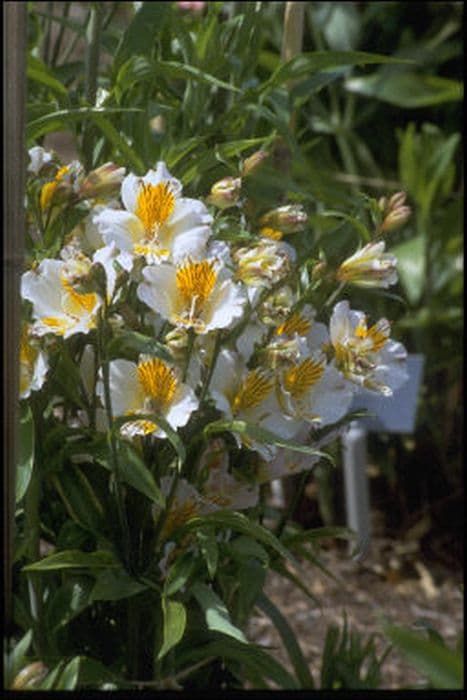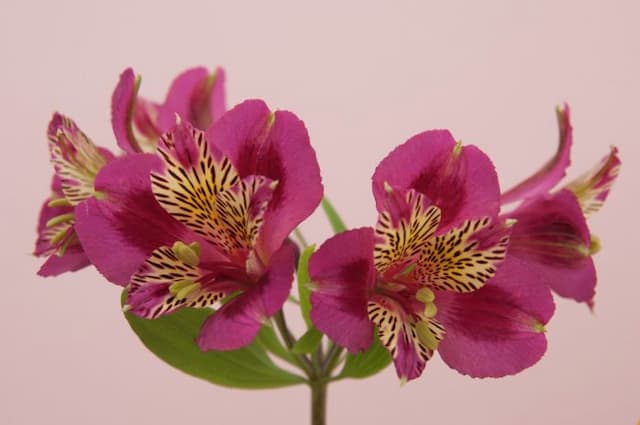Peruvian Lily Alstroemeria Princess Louise = 'Zaprilou' (PBR) (Princess Series)
![Peruvian lily [Princess Louise]](/_next/image?url=https%3A%2F%2Fplants-admin.emdemapps.com%2Fimages%2Fplants%2F%2Fimages%2F604b54aa0a85f.png&w=3840&q=75)
ABOUT
The Alstroemeria Princess Louise, part of the Princess Series, is a striking perennial plant that displays a beautiful array of colors and features. It produces eye-catching flowers that have a unique and intricate design. The flowers bloom in a combination of warm colors, typically showcasing shades of vibrant pink, soft peach, and creamy yellow. Each petal is adorned with dark speckles and streaks that converge toward the center, creating a dramatic contrast and adding to the visual appeal of the flower. The petals are also known for their slightly ruffled edges, which give them a delicate and textured appearance. The foliage of the Alstroemeria Princess Louise is also worth noting, with lance-shaped leaves that create a dense and lush backdrop for the flowers. The leaves are a rich green color and can sometimes have a slight twist or curl, adding to the overall texture of the plant. Although the size and growth habits are not part of this description, it's important to note that this plant, like other Alstroemerias, forms clumps that contribute to its full and robust appearance in the garden setting. This perennial is popular for its long-lasting blooms and vibrant colors, making it a favorite among gardeners and floral enthusiasts.
About this plant
 Names
NamesFamily
Alstroemeriaceae
Synonyms
Peruvian Lily, Lily of the Incas, Parrot Lily
Common names
Alstroemeria Princess Louise = 'Zaprilou' (PBR) (Princess Series).
 Toxicity
ToxicityTo humans
Alstroemeria, commonly known as Peruvian lily or lily of the Incas, is not significantly toxic to humans. However, its sap may cause mild irritation or dermatitis upon contact with the skin in some sensitive individuals. If ingested, parts of the plant may cause minor stomach upset, but it is not considered highly poisonous. There are no severe symptoms of poisoning expected from ingesting the Peruvian lily.
To pets
Peruvian lily is mildly toxic to pets, particularly cats and dogs. If ingested, it can cause gastrointestinal upset, including symptoms like vomiting or diarrhea. While it is not likely to be fatal, it can still cause discomfort and stress to the animal, and a veterinarian should be consulted if significant amounts are ingested or if the pet appears to be in distress.
 Characteristics
CharacteristicsLife cycle
Perennials
Foliage type
Deciduous
Color of leaves
Green
Flower color
Mixed
Height
2 feet (60 cm)
Spread
1 foot (30 cm)
Plant type
Bulb
Hardiness zones
7
Native area
South America
Benefits
 General Benefits
General Benefits- Long Blooming Period: Alstroemeria 'Zaprilou' offers a long flowering season that can extend from late spring to early autumn, providing consistent color in the garden for several months.
- Vibrant Colors: The flowers boast a vibrant mix of pink and yellow hues, which can add brightness and visual appeal to any garden or floral arrangement.
- Attracts Pollinators: The blooms attract a variety of pollinators such as bees and butterflies, which can help pollinate other plants in the garden.
- Low Maintenance: Once established, Alstroemeria 'Zaprilou' is relatively easy to care for, requiring minimal maintenance apart from occasional watering and deadheading.
- Drought Tolerance: Alstroemeria 'Zaprilou' has a moderate tolerance to drought, making it suitable for gardens in drier climates or for gardeners seeking water-wise plants.
- Excellent Cut Flowers: The stems of Alstroemeria 'Zaprilou' are long and sturdy, making them excellent for use in cut flower arrangements with a long vase life.
- Cold Hardy: This cultivar is quite resilient to cold temperatures, making it suitable for growing in a variety of climates.
- Compact Habit: With its compact growth habit, Alstroemeria 'Zaprilou' is well-suited for smaller gardens or for use in containers on patios and balconies.
 Medical Properties
Medical PropertiesThis plant is not used for medical purposes.
 Air-purifying Qualities
Air-purifying QualitiesThis plant is not specifically known for air purifying qualities.
 Other Uses
Other Uses- Photography Prop: Alstroemeria Princess Louise can serve as an elegant subject in macro photography, offering photographers a chance to capture its unique patterns and colors.
- Educational Tool: This flower can be used in botany classes to teach plant reproduction, showcasing how it's pollinated and how it reproduces through rhizomes.
- Artistic Inspiration: Artists may use the Alstroemeria Princess Louise as a muse for paintings, drawings, and textile designs, thanks to its vibrant hues and intricate details.
- Edible Garnish: Although not commonly eaten, the petals of Alstroemeria Princess Louise can be used as a decorative, edible garnish on certain dishes, after ensuring they're free of pesticides.
- Crafts and Decor: The dried flowers of Alstroemeria Princess Louise can be used in crafting activities, such as making potpourri or decorative wreaths.
- Pressing for Keepsakes: The flowers can be pressed and preserved in books or frames, creating natural keepsakes or embellishments for stationery.
- Theme Gardens: Alstroemeria Princess Louise can be planted to create a royalty-themed garden space, given its 'Princess' series designation and regal appearance.
- Floral Language and Symbolism: The flower can be used to convey messages in the Victorian language of flowers, where Alstroemeria symbolizes friendship and devotion.
- Color Dye: The pigments of the Alstroemeria Princess Louise petals may be used in natural dyeing processes for fabrics or paper.
- Ice Cubes: Petals of Alstroemeria Princess Louise can be frozen into ice cubes to add a touch of elegance to beverages at special events.
Interesting Facts
 Feng Shui
Feng ShuiThe Peruvian Lily is not used in Feng Shui practice.
 Zodiac Sign Compitability
Zodiac Sign CompitabilityThe Peruvian Lily is not used in astrology practice.
 Plant Symbolism
Plant Symbolism- Friendship: Alstroemeria, commonly known as Peruvian Lily or Lily of the Incas, is often representative of strong bonds between friends due to its clustered flower form, suggesting a tight-knit grouping.
- Devotion: The flower's twists can symbolize the twists and turns in relationships, which speaks to the endurance and commitment that devotion entails.
- Wealth and Prosperity: With its bountiful petals, the Peruvian Lily may symbolize abundance and wealth, making it an appropriate gift for occasions celebrating success or ambition.
- Achievement: As the flowers tend to grow upwards and come in many colors, they can efficiently depict personal growth and achievement over time.
- Mutual Support: The way the leaves grow upside down, with the back sides facing upwards, is somewhat unique and can symbolize the idea of mutual support and the importance of helping one another.
 Water
WaterPeruvian Lilies should be watered regularly to keep the soil moist, but not waterlogged. During their growing season in spring and summer, watering once a week with 1-2 gallons of water should suffice. The frequency should be reduced during the cooler months to every two weeks. Watering should be done at the base of the plant, avoiding wetting the foliage, which can lead to fungal diseases. In periods of extreme heat or drought, additional water may be necessary to prevent the soil from drying out completely.
 Light
LightPeruvian Lilies thrive best in full sun to partial shade. They prefer a spot that receives at least 6 hours of sunlight a day but also benefits from some afternoon shade in very hot climates. Direct morning sunlight with dappled afternoon light creates an ideal environment for optimal flowering and growth.
 Temperature
TemperaturePeruvian Lilies can endure temperatures as low as 23°F but are happiest in conditions ranging from 65°F to 75°F. They should be protected from severe frost and extreme heat, which can damage the plant. The ideal growing climate does not experience drastic temperature swings and remains within their preferred range.
 Pruning
PruningPeruvian Lilies benefit from pruning to remove spent flowers and to promote continuous blooming. After the blooms fade, cut the stem back to the base to encourage new growth. Prune in late fall or early winter, after flowering has finished for the season, to tidy up the plant and prepare it for the next year. Deadheading regularly while the plant is blooming will also encourage more flowers.
 Cleaning
CleaningAs needed
 Soil
SoilFor the best growth of the Peruvian Lily 'Zaprilou', a well-draining soil mix with loam, sand, and organic matter is recommended; this could be made of two parts loam to one part coarse sand and one part peat or compost. The ideal soil pH should be slightly acidic to neutral, between 6.0 and 7.0.
 Repotting
RepottingPeruvian Lilies such as 'Zaprilou' should typically be repotted every two to three years, or when the plant has outgrown its current container. Overcrowding can limit flowering and overall health, so ensure ample space for root growth when repotting.
 Humidity & Misting
Humidity & MistingPeruvian Lilies like 'Zaprilou' prefer moderate humidity levels, ideally ranging from 40% to 60%. They can tolerate lower humidity, but maintaining this range encourages healthy growth and flowering.
 Suitable locations
Suitable locationsIndoor
Plant in bright, indirect light and ensure good air circulation.
Outdoor
Plant in partial shade or morning sun; protect from strong midday rays.
Hardiness zone
7-10 USDA
 Life cycle
Life cycleThe Alstroemeria Princess Louise, also known as Peruvian Lily from the Princess Series, starts its life as a rhizomatous tuber that germinates in early spring. After germination, it sends up shoots that develop into lush, green foliage and stems. By late spring to early summer, buds appear and unfold into vibrant, trumpet-shaped flowers with distinctive streaks and marks, showcasing a variety of colors that can include pink, orange, purple, and white. The flowering period extends into summer and can last until early fall, depending on the climate and growing conditions. Post flowering, if conditions permit, the plant may go dormant, with its foliage dying back and the tubers resting underground until the next growing cycle. For continued growth, the tubers can be divided every couple of years to rejuvenate the plant and encourage more vigorous flowering.
 Propogation
PropogationPropogation time
Spring to Summer
Propogation: Alstroemeria Princess Louise, commonly known as Peruvian Lily, is best propagated through division, which is the most popular method. The ideal time for this process is in the late winter or early spring when the plant is not actively growing. To propagate through division, carefully lift the clump of rhizomes from the ground with a garden fork, minimizing root damage. The clump should then be gently separated into smaller clumps, ensuring that each section has at least one or two shoots and a portion of the root system. These divisions can be immediately replanted in a prepared garden area or potted up if necessary, spaced about 12 to 24 inches (30 to 60 cm) apart, and watered well to establish. This method allows the plant to recover quickly and continue growing, resulting in new flowering plants that are true to the parent's characteristics.





![Peruvian lily [H.R.H. Princess Alice]](/_next/image?url=https%3A%2F%2Fplants-admin.emdemapps.com%2Fimages%2Fplants%2F%2Fimages%2F604b55e81c8b0.png&w=640&q=75)

![Peruvian lily [Inca Coral]](/_next/image?url=https%3A%2F%2Fplants-admin.emdemapps.com%2Fimages%2Fplants%2F%2Fimages%2F604b5b79b85ce.png&w=640&q=75)
![Peruvian lily [Inca Exotica]](/_next/image?url=https%3A%2F%2Fplants-admin.emdemapps.com%2Fimages%2Fplants%2F%2Fimages%2F604b5ec0e34a9.png&w=640&q=75)
![Peruvian lily [Inca Milk]](/_next/image?url=https%3A%2F%2Fplants-admin.emdemapps.com%2Fimages%2Fplants%2F%2Fimages%2F604b5f14b0b6a.png&w=640&q=75)